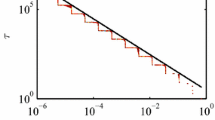Abstract.
We consider the system of \( N (\geq 2) \) hard balls with masses \( m_{1}, \ldots, m_{N} \) and radius r in the flat torus \( \mathbb{T}_{L}^{\nu} = \mathbb{R}^{\nu} / L \cdot \mathbb{Z}^{\nu} \) of size \( L, \nu \geq 3 \) . We prove the ergodicity (actually, the Bernoulli mixing property) of such systems for almost every selection \( (m_{1}, \ldots, m_{N}; L) \) of the outer geometric parameters. This theorem complements my earlier result that proved the same, almost sure ergodicity for the case \( \nu = 2 \) . The method of that proof was primarily dynamical-geometric, whereas the present approach is inherently algebraic.
Similar content being viewed by others
Author information
Authors and Affiliations
Corresponding author
Additional information
Communicated by Eduard Zehnder
Submitted 17/10/02, accepted 01/12/03
Rights and permissions
About this article
Cite this article
Simányi, N. Proof of the Ergodic Hypothesis for Typical Hard Ball Systems . Ann. Henri Poincaré 5, 203–233 (2004). https://doi.org/10.1007/s00023-004-0166-8
Issue Date:
DOI: https://doi.org/10.1007/s00023-004-0166-8




